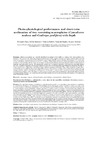Please use this identifier to cite or link to this item:
https://accedacris.ulpgc.es/jspui/handle/10553/49560
| Title: | Photo-physiological performance and short-term acclimation of two coexisting macrophytes (Cymodocea nodosa and Caulerpa prolifera) with depth | Other Titles: | Rendimiento foto-fisiológico y aclimatación a corto plazo de dos macrófitos coexistentes (Cymodocea nodosa y Caulerpa prolifera) con la profundidad | Authors: | Tuya, Fernando Betancor, Séfora Fabbri, Federico Espino, Fernando Haroun, Ricardo |
UNESCO Clasification: | 2417 Biología vegetal (botánica) 241705 Biología marina |
Keywords: | Macroalgae Seagrass Photoacclimation Photo-biology Photoprotection, et al |
Issue Date: | 2016 | Publisher: | 0214-8358 | Journal: | Scientia Marina | Abstract: | Marine macrophytes are vertically distributed according to their ability to optimize their photosynthetic performance. We assessed the photo-physiological performance of the seagrass Cymodocea nodosa and the green seaweed Caulerpa prolifera at varying depth at Gran Canaria Island (Canary Islands, eastern Atlantic). The biomass of C. nodosa decreases with depth, while the opposite occurs for C. prolifera. Photochemical responses of both macrophytes were measured in shallow (5 m) and deep (20 m) waters at two times via chlorophyll a fluorescence and internal content of photoprotective pigments and antioxidant activity. We additionally carried out a reciprocal transplant experiment by relocating shallow and deep vegetative fragments of both macrophytes to assess their short-term photo-physiological acclimation. Overall, C. nodosa behaves as a ‘light-plant’, including a larger optimum quantum yield and ETRmax under scenarios of high photosynthetically active radiation and a larger antioxidant activity. In contrast, C. prolifera is a ‘shade-adapted’ plant, showing a larger carotene content, particularly in shallow water. Deep-water C. nodosa and C. prolifera are more photochemically efficient than in shallow water. The alga C. prolifera shows a rapid, short-term acclimation to altered light regimes in terms of photosynthetic efficiency. In conclusion, decreased light regimes favour the photosynthetic performance of the green alga when both species coexist. Los macrófitos marinos se distribuyen verticalmente de acuerdo a sus capacidades para optimizar su rendimiento fotosintético. Evaluamos el rendimiento foto-fisiológico de la fanerógama marina Cymodocea nodosa y el alga verde Caulerpa prolifera a diferentes profundidades en la isla de Gran Canaria (Islas Canarias, Atlántico oriental). La biomasa de C. nodosa decrece con la profundidad, mientras que para C. prolifera ocurre lo contrario. Las respuestas foto-químicas de ambos macrófitos se midieron en aguas someras (5 m) y profundas (20 m), en dos tiempos, a través de la fluorescencia de la clorofila a y los contenidos internos en pigmentos fotoprotectores y la actividad antioxidante. Además, ejecutamos un experimento de trasplante recíproco, recolocando fragmentos vegetativos de ambos macrófitos entre aguas someras y profundas para determinar su aclimatación a corto plazo. En general, C. nodosa se comporta como “planta de sol”, con mayor rendimiento cuántico óptimo y ETRmax bajo escenarios de alta radiación PAR y mayor actividad antioxidante. Contrariamente, C. prolifera es una “planta de sombra”, mostrando mayor cantidad de carotenos, en particular a poca profundidad. Ejemplares profundos de ambos macrófitos son más eficientes foto-químicamente que los de aguas someras. El alga C. prolifera muestra una aclimatación rápida, a corto plazo, de su eficiencia fotosintética ante cambios en el régimen luminoso. En conclusión, regímenes depauperados lumínicamente favorecen el rendimiento fotosintético del alga verde. |
URI: | https://accedacris.ulpgc.es/handle/10553/49560 | ISSN: | 0214-8358 | DOI: | 10.3989/scimar.04391.07A | Source: | Scientia Marina [ISSN 0214-8358], v. 80, p. 247-259 |
| Appears in Collections: | Artículos |
SCOPUSTM
Citations
5
checked on Jun 8, 2025
WEB OF SCIENCETM
Citations
3
checked on Jun 8, 2025
Page view(s)
108
checked on Nov 9, 2024
Download(s)
101
checked on Nov 9, 2024
Google ScholarTM
Check
Altmetric
Share
Export metadata
Items in accedaCRIS are protected by copyright, with all rights reserved, unless otherwise indicated.
